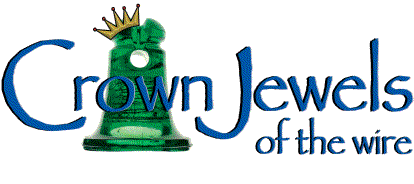Ask Woody
by N. R. Woodward
Reprinted from "Crown Jewels of the Wire", April 1993, page 13
N. R. "Woody" Woodward is the author of THE GLASS INSULATOR IN
AMERICA, 1988 Report and developed
the Consolidated Design Numbers identification system for glass insulators.
The first question comes from Lee Lickiss of Buena Park, California.
QUESTION: I have two Pyrex pieces which are CD 327. However, one is embossed
No. 441 on the skirt and one is embossed No. 461 on the top of the ear of the
insulator. Any information?
Thanks for the question on Pyrex No. 441 and 461. Unfortunately I really have
nothing upon which to build a report. I've never heard of a 461 and just to be
certain, I reviewed my Corning file in detail. No mention of it.
Since its
physical characteristics are so near that of the 441, it seems impossible that would have had a
bearing. Since the glass is a different color, I can only guess that a run was
made using a slightly different formula and that they were marked differently to
ensure proper identification on any follow-up observations in service. But that
is only a guess and hardly ought to be published.
Too bad that Corning trashed
all the records of their insulator production. I've written numerous letters
through the years and visited their plant as well, with no results insofar as
details of product.
NORMAL 441
A =4-5/8"
B = 3-7/8"
C = 1-5/8"
Height = 8-1/16"
Color = yellow tint |
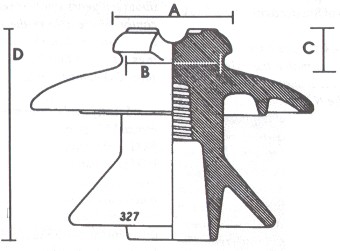 |
EMBOSSED 461
A = 4-15/16"
B = 3-718"
C= 1-7/8"
Height = 8-5/16"
Color = Green tint, similar to a CD 155 Armstrong green smoke, only a little
lighter |
|
Drawing is from Woodward's 1988 Report and records the CD 327 height as 7
5/8" in height.
|
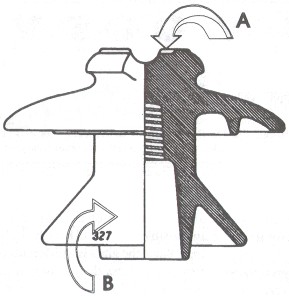 |
A: Location of embossing on the Pyrex CD 327 numbered 461. |
|
B: Location of embossing on the Pyrex CD 327 numbered 441.
|
P .S. An afterthought: Those slight variations in crown dimensions could
have related to desired use of a specific style of preformed tie that did not
fit the conventional 441 quite as they should, although those measurements are
not usually quite that close.
Our second question is submitted by Bob Berry of Stanfordville, New York.
QUESTION: I have a CD 553 Pyrex, but it does not match the existing two known
pieces. It appears to be an exact match to the N.R. Woodward drawing from the
Corning catalogue. It has a height of 9-1/2" and the top skirt measures
12". As can be seen from the pictures, the bottom skirt extends 1-1/2"
below the center skirt. and there is no mini-skirt under the top skirt. The top
skirt appears identical to the two known. The embossing is slightly different.
The embossing is on the inside of the skirt as follows:
1st quadrant: PYREX T.M. REG. U.S. PA
2nd quadrant: T. OFF. MADE IN U.S.A.
Split between 3rd and 4th quadrant: 553
The second quadrant also has a "C"
embossed on the outside of the skirt.
Amazingly enough, I found this at an
antique car flea market -- it just shows that you never know! The guy who had it
said he got it at another flea market about ten years ago! It seems
significantly different from the other 553's, but it does match the original
drawings. It seems that it should not be the same CD number. What do you think?
I really can't write much about the Pyrex 553, since I've never seen one. BUT
I do have catalog drawings of BOTH variations: I have 2 Pyrex catalogs with the
big power styles, not dated but one is obviously earlier than the other. I had
not realized before how different the two 553s are: In checking, I see there are
minor differences in 2 other styles, but not nearly so pronounced as the 553 and probably not needing a separate CD number.
So -- Bob
Berry's "new" 553 remains CD 328, as per the drawing from the newer
catalog that was used in assigning the number originally. The earlier one, of
which Bob says there are two, is now CD 328.2.
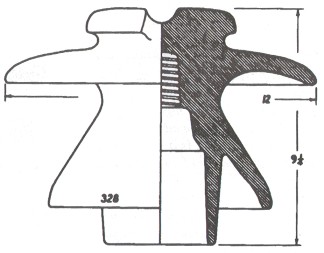
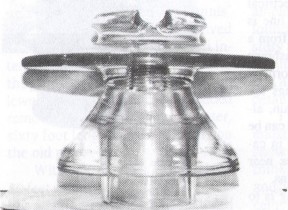
Photo of Bob's CD 328 Pyrex 553
| As a follow up to the
information from Lee Lickiss, Bob sent a photograph of a
CD 327 Pyrex 441which has the 461 embossed on the top. Bob comments that the 461 is
about 1/2 inch taller than the 441. |
 |
Our last question is from Charles Lindsay from Modesto, California.
QUESTION: I was wondering if you could help me to identify this insulator and
maybe what it would be worth. The glass portion is 5-3/4" high, 2-1/2"
in diameter. The top has a metal wire nut connector, and there is a wire (bare)
running the length of the insulator (about the #12 wire size). On the base is
the marking T3. There are threads inside. it is smooth. It had to be some kind
of hanging insulator. Thank you for any help that you can give me.
The insulator that you have is, in fact. not a line insulator but rather a
bushing. These bushings are used on electrical equipment where the primary line
is brought in. Probably yours is from a capacitor, although similar bushings have been used for large transformers and other equipment. Bushings are more
often made from porcelain, although glass ones such as yours can be seen atop
capacitors, typically in capacitor banks located on poles near rural communities
or small towns.
The purpose of the bushing is to prevent the line from being
grounded to the case of the capacitor or transformers. The long corrugated
surface prevents an arc from forming in wet weather. Longer bushings are used
for higher voltages.
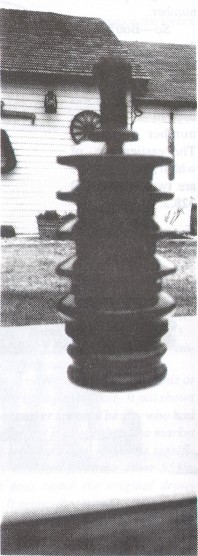
| 